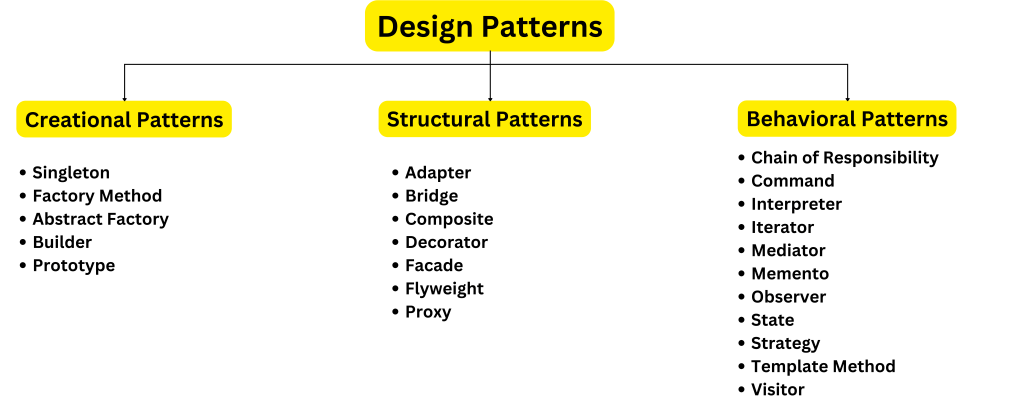Table of Contents
What is a Design Pattern?
A software design pattern is a general reusable solution to a commonly occurring problem within a given context in software design. It represents best practices evolved by experienced software developers.
Design patterns are not templates or finished designs that can be transformed directly into code. Instead, they provide general principles and guidelines for solving particular design problems.
Design patterns can speed up the development process by providing tested, proven development paradigms. They facilitate communication between designers and developers and can be used to capture expert knowledge and design decisions for future reference.
Applying design patterns can improve the maintainability and scalability of software systems, as they encapsulate good design practices and promote code reuse. However, it’s important to use them judiciously and not force their application in every situation, as each pattern is designed to solve a specific set of problems
Why do we need Design Patterns?
Now that you have some idea about what design patterns are, you might wonder if you might wonder if there are any benefits to learning design patterns.
“Isn’t it okay to use not-so-well-structured code (“Spaghetti Code“) as long as it does the job? “
The answer is you might be able to get away with that beginner-level or intermediate-level code in your college sample projects or quizzes. However, when it comes to production settings, working with a team of developers, you need to work with a large code base following the best practices in the industry while keeping your communication with other team members. And your college-level code used in your assignments does not help in production settings.

The following are some of the reasons why you must learn Software design patterns:
1. Reusable Solutions: Design patterns provide tried-and-tested solutions to common problems.
2. Best Practices: Design patterns embody best practices and design principles. Following these patterns helps ensure that your code adheres to proven design principles.
3. Communication and Collaboration: Design patterns provide a common vocabulary and set of solutions that developers can use to communicate ideas and collaborate on projects.
4. Ease of Maintenance and Scalability: Design patterns contribute to code maintainability by promoting a clear and organized structure. When developers follow well-established patterns, it becomes easier for others (or even the original developers) to understand and modify the codebase. This is particularly important in large and complex software systems.
Systems designed with patterns are generally easier to evolve as new requirements emerge. Developers can leverage patterns to introduce changes without causing widespread disruptions to the existing code. By promoting modular and loosely-coupled components, patterns allow for easier extension and modification of a system as requirements evolve.
6. Problem Solving: Design patterns encapsulate solutions to specific design problems. When facing a particular challenge, developers can refer to existing design patterns to see if there’s a known and effective solution. This can save time and effort in problem-solving.
7. Code Quality: Following design patterns often leads to higher-quality code. Patterns encourage separation of concerns, modularity, and adherence to principles such as the Single Responsibility Principle (SRP) and Open/Closed Principle (OCP), which contribute to cleaner and more maintainable code.
Classification of Design patterns
We can categorize these design patterns into three main groups based on the primary focus and purpose.

- Creational Patterns: These patterns deal with the process of object creation. They help in controlling which classes to instantiate and how to instantiate them. Examples include the Singleton, Factory Method, Abstract Factory, Builder, and Prototype patterns.
- Structural Patterns: These patterns are concerned with the composition of classes or objects to form larger structures. They help in organizing code flexibly and efficiently. Examples include the Adapter, Bridge, Composite, Decorator, Facade, Flyweight, and Proxy patterns.
- Behavioral Patterns: These patterns are related to the interaction and responsibility of objects. They define patterns of communication between classes and objects, which make the system more flexible and efficient. Examples include the Chain of Responsibility, Command, Interpreter, Iterator, Mediator, Memento, Observer, State, Strategy, Template Method, and Visitor patterns.
How do you choose the correct design pattern?
Choosing a design pattern involves a few aspects to consider. You consider specific requirements, context, and the goal of your project. Some of the guidelines that can be helpful for you are listed below:
- Deep Understanding of the Problem Domain:
- Prioritize a thorough understanding of the problem before choosing a design pattern.
- Future-Proof Design:
- Anticipate future changes and select patterns allowing easy adaptability.
- Balance Flexibility and Simplicity:
- Choose simple designs that meet current requirements without unnecessary complexity.
- Single Responsibility Principle (SRP):
- Design classes with a single responsibility to avoid overloading.
- Composition Over Inheritance:
- Prefer composition for better code reuse and maintainability.
- Adapt Patterns to Context:
- Tailor design patterns to the specific needs and context of the project.
- Regular Review and Refactoring:
- Conduct regular code reviews and embrace continuous refactoring for improved code quality.
- Consider Performance Implications:
- Evaluate and optimize for performance, considering potential trade-offs.
- Document Design Decisions:
- Document the rationale behind chosen design patterns for effective communication.
- Learn and Iterate:
- Analyze and learn from past projects, continuously improving design skills.
- Stay Updated on Emerging Patterns:
- Keep abreast of new design patterns and best practices for ongoing improvement.
- Align with Team Expertise:
- Assess the development team’s skillset when selecting design patterns, fostering knowledge sharing.
Wrapping up
- Design patterns are reusable and proven solutions to common problems that software developers encounter during the design and implementation of software systems.
- These patterns provide a structured and efficient way to organize code, promote code reuse, and enhance the overall maintainability of a software project. By following established design patterns, developers can leverage best practices and established solutions, leading to more robust, flexible, and scalable software architectures.
- It’s crucial to apply design patterns judiciously, considering the specific needs of the project, to avoid potential pitfalls such as over-engineering or misapplication. Design patterns serve as a valuable toolkit for developers, offering guidance on addressing recurring challenges and fostering the creation of well-organized, modular, and adaptable software systems.

Pingback: Unlock the Singleton Pattern: Transform and Elevate Your Code – TecForFun